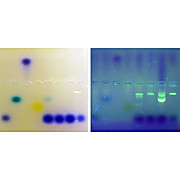G-Biosciences Education, Biology
-
Gel Box Science Kit
G-BiosciencesThis Biotechnology Basics™ kit by Ellyn Daugherty is designed to teach the basic principles of a gel box, specifically horizontal agarose gel electrophoresis. The kit is supplied with all the reagents necessary to conduct 4 gel box science experiments, each using a gel box (not supplied). …
-
Microorganisms In Our Environment Kit
G-BiosciencesMicroorganisms, such as bacteria and fungi, are all around us. This kit allows students to collect samples from the world around them and grow the microorganisms so that students can visualize the microorganisms. This teaches students how to plate and grow microorganisms. …
-
This kit is designed to teach 8 groups of four students the principles of the polymerase chain reaction (PCR) The kit contains the reagents to allow students to: Set up multiple PCR reactions using pAmylase plasmid DNA and bacterial genomic DNA templates Set up a PCR negative…
-
DNA Ligation Kit
G-BiosciencesFollowing restriction enzyme digestion of DNA molecules, researchers need to rejoin the ends of the DNA to generate recombinant DNA, a process known as ligation. Ligation of DNA is achieved with the bacterial enzyme T4 DNA ligase, which catalyzes the formation of phosphodiester bonds. …
-
The rAmylase Project: Assaying for Amylase Activity Kit
G-BiosciencesThis kit is designed to teach 8 groups of four students the principles of enzyme assays. The kit contains the reagents to allow students to test for the presence and activity of 2 different types of amylase by: Visualizing the breakdown of the starch substrate by the amylase…
-
Immunoaffinity Chromatography Kit
G-BiosciencesA hands on lab activity to study immunoaffinity chromatography and use a specific antibody to purify antigenic proteins from complex samples. This technique involves performing a chromatography procedure using antigen or antibody immobilized on a chromatographic resin. The solution…
-
Plasmid Isolation (Alkaline Lysis) Kit
G-BiosciencesBacterial plasmids, the non-genomic transferable DNA, can easily be purified from bacteria using numerous techniques. The purification of DNA is important for genetic research as it provides a source of transferable DNA and allows researchers to isolate large amounts of recombinant DNA. …
-
Antibiotic Sensitivity & Bacteria Screening Kit
G-BiosciencesAntibiotics play a crucial role in the manipulation, screening and killing of bacteria in a range of biotechnology processes. This kit specifically teaches the basic principles of antibiotics, bacterial resistance and susceptibility. Students learn and understand the use of antibiotic…
-
This kit is designed to teach 8 groups of four students the principles of restriction digestion and agarose electrophoresis. The kit contains the reagents to allow students to: Set up restriction digests of the p-Amylase plasmid with two enzymes Set up positive and negative controls for the…
-
Onion Genomic DNA Isolation Kit
G-BiosciencesIsolation of genomic DNA is an essential technique in modern research science, particularly molecular biology and biotechnology. Genomic DNA is purified from a multitude of sources including mammalian tissue, such as cheek cells , plant cells or bacterial cells. These kits use detergent…
-
Expression of a Recombinant Protein Kit
G-BiosciencesThe final goal in molecular biology is often the expression of a recombinant protein. The transformed plasmids can be used as templates by the bacteria to produce protein. Students learn about essential promoters and other elements necessary for successful protein expression in…
-
DNA Restriction Digestion Analysis Kit
G-BiosciencesRestriction enzymes are DNA-cutting enzymes found in bacteria and as they cut within the molecule, are often called restriction endonucleases. A restriction enzyme recognizes and cuts DNA only at a particular unique sequence of nucleotides, allowing for restriction sites to be mapped. …
-
Conservation of Genetic Information Kit
G-BiosciencesThe protein make-up of an organism is unique to that individual species, however many essential proteins are highly conserved. This level of conservation can be seen when protein fingerprinting is used to compare and contrast different organisms. The Conservation of Genetic Information…
-
DNA Strands Revealed Kit
G-BiosciencesOne of the most important molecules in an organism is its genomic DNA. Genomic DNA is found in every cell of an organism and carries all the necessary information required to make that organism. This kit provides all the reagents required to visualize genomic DNA strands by a…
-
This kit is designed to teach 8 groups of four students the principles of plasmid DNA purification by minipreps. The kit contains the reagents to allow students to: Collect p-Amylase-transformed bacteria from an overnight culture Resuspend bacteria, lyse and isolate the p-Amylase…
-
Affinity Chromatography Kit
G-BiosciencesAffinity chromatography is a powerful tool for the purification of specific biomolecules, including proteins. The basic principle is that a biospecific ligand is immobilized to a solid support or resin to which a solution containing the protein of interest is passed over. Ligands are often based on…
-
Southern Blot Analysis Teaching Kit
G-BiosciencesSouthern blot analysis, named after its inventor Edwin M. Southern, is a common research technique for enhancing the results of agarose electrophoresis. DNA is resolved on an agarose gel and is subsequently transferred to a nylon membrane. The resulting membrane can be probed for…
-
Nucleic Acid Quantification Kit
G-BiosciencesThe kit utilizes the principle of diffusion of nucleic acids on a nylon membrane to determine their concentration. No spectrophotometers required. Nucleic acid concentration can be measured by measuring the diameter of diff used nucleic acid spots or comparing the color density of the spots with…
-
Enzyme Analysis Kit
G-BiosciencesEnzymic proteins are functional molecular engines of life and as such carry out cellular reactions in cells. Enzymes convert a target molecule (substrate) into a different molecule (product). Enzymes have a number of distinct advantages over conventional chemical catalysts. The most distinctive…
-
Protein Cross-Linking Kit
G-BiosciencesA single protein molecule rarely carries out its role in the body on its own. Many proteins and cofactors are often involved and act as regulators, activators or inhibitors of the protein’s function. Researchers are constantly on the hunt for biomolecules that interact with their…
-
Protein Folding Study Kit
G-BiosciencesA proteins life cycle begins once its gene is turned on and its mRNA is transcribed and translated to produce the polypeptide strand. The correct folding of a protein is the first crucial stage of the life cycle of a protein. Correct folding is essential for a protein to be functional, whereas…
-
Immunoquantification Technique (ELISA) Kit
G-BiosciencesLab activity that teaches the use of lock-key matching properties of antigen-antibody for detection as well as quantification of antibody or antigenic proteins in complex samples. This method is widely known as Enzyme Linked Immunosorbent Assay, or ELISA. In this lab activity, students…
-
This kit is designed to teach 8 groups of four students the principles of protein concentration estimation assays. The kit contains the reagents to allow students to: Conduct a serial dilution of a stock amylase solution to create standards of known concentration Use a Bradford protein…
-
Recombinant Protein Purification Kit
G-BiosciencesMolecular cloning is a commonly used technique for the generation of recombinant proteins. The gene for a protein of interest is cloned into a vector, or plasmid, in frame with the gene for a protein tag. These tags are used to purify expressed protein by established…
-
Bacterial Genomic DNA Isolation Kit
G-BiosciencesOur Genomic DNA Isolation kits is supplied with dried E.coli and all the ncessary prealiquoted components to isolate bacterial genomic DNA from the bacteria and use G-Biosicences Nucleic Acid Assay to determine the amount of DNA extracted. In addition, a class demonstration is include to…
-
Protein Degradation Study Kit
G-BiosciencesThe cellular environment is a constant dynamic with the continued synthesis, degradation and recycling of protein molecules. This dynamic allows for close regulation of cellular processes by switching off cellular pathways by degrading key proteins. The degradation of proteins is controlled…
-
Biotechnology in Your Mouth Kit
G-BiosciencesThe subjects of life sciences and biotechnology allow students to learn about the fundamental building blocks of life, including their proteins. In addition, biotechnology teaches us how scientists manipulate proteins in industrial applications. This kit allows students to study their…
-
Protein Fractionation Kit
G-BiosciencesThe aim of proteomics is to identify and characterize all the proteins in an organism. The major restrictions in protein identification are the large number of proteins and the huge differences in abundance. These restrictions mean low abundance, critical proteins are often masked and…
-
Biodiversity Study & Biomass Analysis Kit
G-BiosciencesBiodiversity lab activity is designed for determination of protein contents and biomass in diverse biological samples to study how biomass is related to biodiversity in nature. Students collect and catalog plant leaf samples from a diverse group of locally available plants. This lab…
-
Bacterial Culture & Growth Study Kit
G-BiosciencesThis kit teaches aseptic handling techniques and cultivation of bacteria in liquid culture media and on solid phase agar plates. This kit is designed to educate students about the various stages of the bacterial growth cycle, i.e. lag, log or exponential, stationary, and decline…
-
Protein Labeling Kit
G-BiosciencesProtein labeling is an important technique that allows researchers to study a protein’s location, movement and interactions within a living cell. The most common labels used are fluorescent labels that allow researchers to study proteins with fluorescent microscopy…
-
Genomic DNA Spooling Kit
G-BiosciencesOur Genomic DNA Spooling kit allows for 8 groups of 2-4 students to spool salmon testes DNA onto a spooling rod. This lab module allows students to precipitate the DNA from solution before spooling (winding) onto a rod. The recovered DNA is returned to solution and the students then use…

























